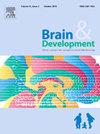Low excretor glutaric acidemia type 1 with transient lesions in the basal ganglia
IF 1.3
4区 医学
Q4 CLINICAL NEUROLOGY
引用次数: 0
Abstract
Background
In some countries, glutaric acidemia type 1 (GA1) is included in newborn screening (NBS) panels using tandem mass spectrometry (MS/MS) analysis of acylcarnitine. However, the low excretor phenotype of glutaric acidemia type 1 (LE-GA1) has been increasingly recognaized and may lead to false-negative NBS results and can be missed by urine organic acid and plasma acylcarnitine profile analyses.
Case
We report a case of LE-GA1 with an atypical imaging course. NBS by dried blood spot acylcarnitine profile using MS/MS was normal. At 7 months of age, he developed an acute encephalopathic crisis with bilateral striatal lesions. He underwent intravenous methylprednisolone pulse, intravenous immunoglobulin, vitamin B1, biotin, l-carnitine, and coenzyme Q10 therapy. Abnormal basal ganglia signals disappeared within 4 weeks. Serial brain MRI 6 months later revealed linear lesions in both putamen. The plasma acylcarnitine profile and urine organic acid analyses were normal at onset. Whole exome and Sanger sequencing were performed, and compound heterozygosity for the two known pathogenic variants in the glutaryl-CoA dehydrogenase gene were identified. Metabolomic analyses of the patient's urine showed elevated glutaric acid and 3-hydroxyglutaric acid levels similar to those in another LE-GA1 case. Thus, the patient was diagnosed with LE-GA1.
Conclusions
Unlike classical GA1, LE-GA1 may present with variable neuroimaging courses, including transient basal ganglia lesions. If Leigh's encephalopathy-like lesions of the basal ganglia—of unknown cause with acute onset—are present, LE-GA1 should be considered. To ensure timely and accurate diagnosis, genetic analyses should be performed, even if biochemical findings are normal.
低分泌型戊二酸血症伴基底节区暂时性病变
在一些国家,戊二酸血症1型(GA1)被纳入新生儿筛查(NBS)面板,使用串联质谱(MS/MS)分析酰基肉碱。然而,戊二酸血症1型(LE-GA1)的低排泄表型已被越来越多地认识到,可能导致NBS结果假阴性,并且可能在尿有机酸和血浆酰基肉碱谱分析中被遗漏。我们报告一例LE-GA1,其影像学表现不典型。MS/MS法测定干血斑酰基肉碱谱NBS正常。7个月大时,他出现了急性脑病危象,伴有双侧纹状体损伤。他接受了静脉注射甲基强的松龙、静脉注射免疫球蛋白、维生素B1、生物素、左旋肉碱和辅酶Q10治疗。异常基底神经节信号在4周内消失。6个月后的连续脑MRI显示双侧壳核呈线状病变。发病时血浆酰基肉碱谱和尿有机酸分析正常。进行了全外显子组和Sanger测序,鉴定了两种已知致病变异的戊二酰辅酶a脱氢酶基因的复合杂合性。患者尿液的代谢组学分析显示戊二酸和3-羟基戊二酸水平升高,与另一个LE-GA1病例相似。因此,患者被诊断为LE-GA1。结论与经典GA1类似,LE-GA1可能表现为不同的神经影像学过程,包括短暂的基底神经节病变。如果存在雷氏脑病样基底神经节病变,原因不明,急性发作,则应考虑LE-GA1。为了确保及时准确的诊断,即使生化结果正常,也应进行遗传分析。
本文章由计算机程序翻译,如有差异,请以英文原文为准。
求助全文
约1分钟内获得全文
求助全文
来源期刊

Brain & Development
医学-临床神经学
CiteScore
3.60
自引率
0.00%
发文量
153
审稿时长
50 days
期刊介绍:
Brain and Development (ISSN 0387-7604) is the Official Journal of the Japanese Society of Child Neurology, and is aimed to promote clinical child neurology and developmental neuroscience.
The journal is devoted to publishing Review Articles, Full Length Original Papers, Case Reports and Letters to the Editor in the field of Child Neurology and related sciences. Proceedings of meetings, and professional announcements will be published at the Editor''s discretion. Letters concerning articles published in Brain and Development and other relevant issues are also welcome.
 求助内容:
求助内容: 应助结果提醒方式:
应助结果提醒方式:


